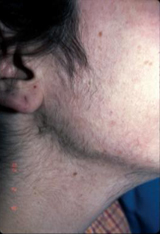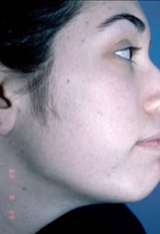 Laser hair removal involves the removal of unwanted facial or body hair with laser light.
Laser hair removal involves the removal of unwanted facial or body hair with laser light.
Lasers produce intense light that is absorbed by the pigment in hair called melanin. The melanin absorbs the light and heats up. This heat damages the hair follicle without hurting the surrounding tissue. The damaged hair follicle stops producing hair or replaces thick adult hair with a fine, light-colored hair (vellus hair).
Traditional hair removal methods, such as waxing, shaving, and plucking, remove only the hair shaft. This leaves the hair follicle in place to grow new hair. Electrolysis delivers an electrical current to each follicle that can lead to permanent hair removal. However, it is painful and slow and usually requires multiple treatments over months or years.
Laser hair removal is a safe, effective, and convenient alternative to other methods. Lasers can treat large areas quickly, often in the time it takes to shave. Improvements may be seen after only one treatment, but repeat treatments are usually required to achieve desired results.
Improvements may be seen after only one treatment, but repeat treatments are usually required to achieve desired results.
After treatment, the area may appear swollen and feel like a mild sunburn.
Factors that Influence Results
Results of laser hair removal depend on several factors, including:
- Hair color—Lasers are most effective for dark hair. Light hair lacks sufficient melanin to absorb the light and heat up the hair follicle.
- Hair thickness—Thicker hairs respond better than thinner hairs.
- Skin color—Previously, only fair-skinned people could be treated with lasers for hair removal. Now dark-skinned individuals
 can also be treated, but gentler and more numerous treatments may be required to deliver the same results.
can also be treated, but gentler and more numerous treatments may be required to deliver the same results. - Body area—Arms, legs, underarms, and hair in the bikini area respond best to treatment. Facial hair (chin and lip) tends to be more resistant.
People of all skin colors and hair types will benefit from some delayed hair re-growth for as long as 6 months after one treatment. However, because not all hair follicles are active at the same time, multiple treatments are usually needed to remove all hair from each area. Most people require 3–6 treatments, 4 to 6 weeks apart. After the initial round of treatments, your doctor may recommend maintenance treatments once or twice per year.Along with mild side effects, some people may experience scarring or changes in skin color, although these changes are rare and usually resolve quickly. You can minimize these risks by carefully following your pre- and post-treatment instructions.
Source: Vivacare
Last updated : 12/13/2021